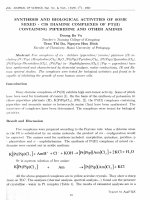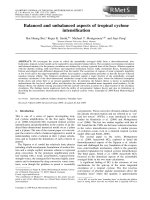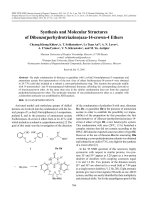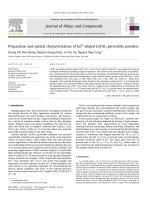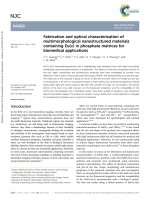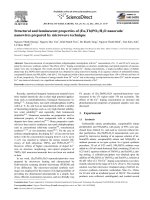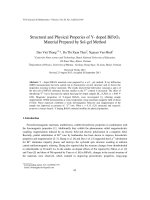DSpace at VNU: Magnetic and Mossbauer studies of the DyFe11Mo compound
Bạn đang xem bản rút gọn của tài liệu. Xem và tải ngay bản đầy đủ của tài liệu tại đây (162.38 KB, 7 trang )
Journal of Magnetism and Magnetic Materials 237 (2001) 10–16
.
Magnetic and Mossbauer
studies of the DyFe11Mo compound
V.T. Hiena, J.M. Le Bretonb,*, N.T. Hiena,c, L.T. Taia,c, N.P. Thuya,c, N.H. Duca,
N.P. Duongc, J. Teilletb
a
Cryogenic Laboratory, Faculty of Physics, National University of Hanoi, 334 Nguyen Trai, Thanh Xuan, Hanoi, Viet Nam
b
!
Groupe de Physique des Materiaux,
UMR CNRS 6634, Universite! de Rouen, 76821 Mont-Saint-Aignan Cedex, France
c
International Training Institute for Materials Science (ITIMS), 1 Dai Co Viet, DHBK Hanoi, Hanoi, Viet Nam
Received 1 June 2001; received in revised form 19 July 2001
Abstract
.
A detailed magnetic and Mossbauer
study focusing on intrinsic magnetic and anisotropy properties of the DyFe11Mo
compound is reported. The compound shows a spin reorientation phase transition at Tsr ¼ 220 K. Anomalies in
physical properties such as saturation magnetization, AC-susceptibility and hyperfine field at Tsr were identified,
analysed and are discussed in terms of the individual site anisotropy model. r 2001 Elsevier Science B.V. All rights
reserved.
PACS: 75.30.Àm; 75.30.Cr; 76.80.+y; 75.50.Bb
.
Keywords: Rare earth-transition metal intermetallics; Spin reorientation; Mossbauer
spectrometry
1. Introduction
The pseudobinary intermetallics RFe12ÀxMx
(R=rare earths; M=Ti, V, Cr, Mn, Mo, W, Al
or Si and x varying from 0.5 to 4.0 depending on
the type of the stabilizing element M) have been
intensively studied in the last decade [1–5]. These
compounds crystallize in the ThMn12 structure
and exhibit many interesting magnetic and electronic properties. It is known that in the compounds containing R elements with a negative
second-order Stevens factor aJ ; the rare-earth (4f)
*Corresponding author. Tel.: +33-2-35-14-67-66; fax: +332-35-14-66-52.
E-mail address:
(J.M. Le Breton).
sublattice shows a planar anisotropy, whereas the
Fe (3d) sublattice has a uniaxial easy axis
anisotropy. The competitive anisotropy contributions from the two sublattices can lead to spin
reorientation phase transitions as the temperature
changes, inducing rotations of the resultant
magnetic moments with respect to the crystallographic directions. This phenomenon can be
evidenced by an abrupt variation of the hyperfine
fields at the 3d site [6]. In the DyFe12ÀxMox
compounds, where Dy has a negative Stevens
factor aJ ; the sign of the overall magnetic
anisotropy constant changes at a temperature Tsr
leading to a spin reorientation phase transition at
this temperature. These compounds, therefore, can
serve as an outstanding example for studying the
above-mentioned observable phenomena.
0304-8853/01/$ - see front matter r 2001 Elsevier Science B.V. All rights reserved.
PII: S 0 3 0 4 - 8 8 5 3 ( 0 1 ) 0 0 4 8 1 - 4
V.T. Hien et al. / Journal of Magnetism and Magnetic Materials 237 (2001) 10–16
In general, spin reorientation phase transitions
are macroscopically studied by means of magnetic
property investigations, e.g. magnetization and
.
susceptibility measurements. Mossbauer
effect
measurements, on the other hand, can provide
useful information on microscopic properties of
the system, e.g. the discontinuity in the hyperfine
fields at the 3d site at Tsr which reflects the orbital
contribution to the 3d magnetic moment at a given
site. This information, therefore, enables one to
consider the local anisotropy at each 3d site in this
type of compounds [6].
In this paper, we present a study of the intrinsic
magnetic and anisotropy properties of the DyFe11Mo compound. Attention is focused on the
magnetization and hyperfine field changes around
the spin reorientation phase transition temperature
Tsr : The results are discussed in terms of the
individual site anisotropy (ISA) model.
2. Experimental
A DyFe11Mo compound was prepared by arcmelting the constituents in the nominal stoichiometric composition in a protective atmosphere of
pure argon (99.99%). Pure metals (Dy of 99.9%,
Fe and Mo both of 99.99% purity) were used. In
order to ensure its homogeneity, the as-melt
sample was several times turned and melted again.
We have added about 2 wt% excess of Dy to
compensate the rare earth lost caused by evaporation during the repeated melting procedure. The
ingot obtained was then annealed at 10001C for
70 h in a pure argon atmosphere. At the end of the
annealing procedure the sample was quenched in
water down to room temperature and then used
for the measurements. Samples were characterized
by X-ray diffraction using a Philips APD 1700
diffractometer with a copper anticathode
(lKa ðCuÞ D0:1540 nm). For the study of the magnetocrystalline anisotropy, oriented powder samples
were fabricated by mixing the sample powder with
a non-magnetic epoxy resin, and orienting the
mixture along the easy direction of magnetization
in a magnetic field of about 1 T.
Magnetic measurements were carried out by
means of different types of magnetometers, such as
11
extraction magnetometer (EM), vibrating sample
magnetometer (VSM), SQUID-magnetometer and
AC-susceptometer in varying temperatures and
fields up to 600 K and 5 T, respectively.
.
Mossbauer
spectra were recorded in the temperature range from 77 to 300 K in transmission
geometry using a 57Co source in a rhodium matrix.
.
The Mossbauer
sample contains about 10 mg/cm2
of natural ion.
3. Results and discussion
Fig. 1 presents the X-ray diffraction pattern of
the as-prepared sample. The pattern shows typical
reflections of the well-known ThMn12 structure.
As can be seen, an impurity phase in form of a-Fe
is present in the sample. The lattice parameters
were determined from the diffraction pattern and
yielded values of a ¼ 0:8513 and c ¼ 0:4775 nm for
the tetragonal unit cell. These parameters are in
very good agreement with published data [7].
In Fig. 2, we show the magnetization as a
function of the temperature for DyFe11Mo measured in the temperature range from 77 to 600 K in
an applied field of 0.1 T. As one can see in this
figure, the MðTÞ curve exhibits two distinguished
features at about 220 and 460 K. The 220 K
anomaly is ascribed to the spin reorientation phase
transition whereas the 460 K anomaly can be
interpreted as the Curie temperature of this
Fig. 1. X-ray diffraction pattern of the DyFe11Mo sample. The
peaks of the DyFe11Mo compound are indexed in the figure.
The main peak of the a-Fe phase is also indicated.
12
V.T. Hien et al. / Journal of Magnetism and Magnetic Materials 237 (2001) 10–16
Fig. 2. Thermal variation of the magnetization measured in a
field of 0.1 T for DyFe11Mo.
compound. The magnetization measured above
460 K does not completely diminish clearly confirming the presence of the a-Fe phase in the
sample although it is not a significantly large
contribution. The spin reorientation phase transition of DyFe11Mo is also confirmed by the AC
susceptibility (wAC ) measurements (see Fig. 3).
From this figure, another anomaly is visible at
about 35 K. The origin of this anomaly, however,
is still unknown and its characterization is beyond
the scope of this article.
The magnetization isotherms MðHÞ measured at
5, 77 and 300 K on a free powder DyFe11Mo
sample is shown in Fig. 4. It is clearly seen that the
high field magnetic susceptibility is rather large, in
particular at T ¼ 5 and 77 K. In addition, the
magnetization measured at 77 K is larger than that
at both 5 and 300 K. The inset shows the MðTÞ
curve measured from 5 to 300 K in an applied field
of 5 T. The curve exhibits a broad maximum
around 200 K. Again, this may originate from the
thermal variation of the spin configuration in the
sample. From the 5 K curve, a value of 10.0 mB was
determined for the spontaneous magnetization.
Assuming a value of mDy ¼ 10 mB for the free Dy3+
ion-moment at low temperatures, we derived a
value of mFe E1:82 mB for the moment of the Fesublattice at 5 T. This value is well below that of
metallic iron (mFe E2:2 mB). This indeed is a
Fig. 3. Temperature dependence of AC susceptibility for
DyFe11Mo.
Fig. 4. Magnetization isotherms of DyFe11Mo. The inset
shows the magnetization measured in an applied field of 5 T
as a function of the temperature.
common behaviour observed for the Fe-moment
in RFe12ÀxMx compounds [2], which is influenced
by the additional 3d(Fe)–3d(M) hybridization.
The magnetization as a function of the angle
between the applied field and the aligned direction
of an oriented-powder sample, measured at liquid
nitrogen and room temperature using a field of
V.T. Hien et al. / Journal of Magnetism and Magnetic Materials 237 (2001) 10–16
13
Fig. 5. Magnetization as a function of the angle between the
applied field and the alignment direction of a DyFe11Mo
aligned powder sample, measured at 300 and 77 K in a field of
0.3 T.
0.3 T, is presented in Fig. 5. It can be seen from
this figure that at T ¼ 77 K (oTsr ), the easy
magnetization direction (EMD) makes a coneangle (around 451) with respect to the c-axis which
is the EMD of the compound at T ¼ 300 K (> Tsr ).
This is in good agreement with the observation
reported by Yang et al. [8] and again confirms the
spin reorientation phenomenon evidenced in the
other measurements mentioned above.
.
The Mossbauer
spectra of the as-prepared
DyFe11Mo compound at different temperatures
are reported in Fig. 6. The spectra were fitted
consistently in the whole temperature range
according to the following assumptions: (i) Like
the magnetic moment, the hyperfine field at a given
Fe site is mainly governed by the Fe–Fe exchange
interactions, depending on both the number of Fe
nearest neighbours and the corresponding interatomic Fe–Fe distances [2]. The order of Bð8iÞ
hf >
ð8fÞ
Bð8jÞ
>
B
is
thus
assumed
for
the
hyperfine
fields
hf
hf
of the three Fe sites of the ThMn12 structure, in
.
agreement with Mossbauer
spectrometry and
neutron diffraction data [2,9]. (ii) The Mo atoms
are substituted for Fe on the 8i site only, as
supported by experimental data [10,11]. This is in
agreement with the positive enthalpy contribution
associated with R and Mo, the R atoms having
.
Fig. 6. Mossbauer
spectra of the DyFe11Mo compound in the
temperature range from 77 to 300 K.
four nearest 8i-site neighbours compared with
eight nearest 8j- and 8f-sites neighbours [11]. The
.
Mossbauer
relative intensities of the different Fe
sites in the DyFe11Mo compound were thus
constrained to the following values: 27.2% for 8i,
36.4% for 8j and 8f sites. (iii) Each site contribution is fitted with a discrete distribution of
magnetic sextets, in order to account for the
distribution of environments around the Fe atoms,
due to the presence of Mo. The hyperfine field
corresponding to each site is the mean value of the
corresponding distribution. (iv) As evidenced by
14
V.T. Hien et al. / Journal of Magnetism and Magnetic Materials 237 (2001) 10–16
X-ray diffraction and thermomagnetic analysis,
some small amount of a-Fe is present in the
.
sample. Its Mossbauer
relative intensity can be
deduced from the fitting of the room temperature
spectrum, as its contribution is clearly distinguishable from that of the pure DyFe11Mo phase: the
obtained value is 5%. Thus, the contribution of aFe is fitted in each spectrum with a relative
intensity fixed to 5%. At each temperature, the
contribution of the DyFe11Mo phase thus represents 95% of the intensity of the spectrum.
From these fittings, the mean hyperfine field of
the DyFe11Mo compound and the hyperfine fields
(Bhf ) of each Fe 3d site contribution were
obtained. Their temperature dependence is presented in Figs. 7a and b, respectively. As shown in
Fig. 7a, the average hyperfine field gradually
decreases as the temperature rises. In the temperature region around the spin reorientation phase
transition (between 220 and 240 K) an obvious
discontinuity is evidenced. This discontinuity is
also apparent in the curves corresponding to the
Fig. 7. Temperature dependence of (a) the mean hyperfine field
/Bhf S and (b) the hyperfine field Bhf at each Fe site of the
DyFe11Mo compound. The full lines are guides for the eye.
temperature evolution of the hyperfine fields at
each single Fe site (see Fig. 7b).
The average hyperfine field extrapolated to 0 K
(see Fig. 7a) reaches a value of /Bhf S ¼ 28:6 T
corresponding to /mFe S ¼ 1:83 mB/Fe by using the
conversion factor of 15:6 T/mB from hyperfine field
to magnetic moment [1]. Indeed, this is in good
agreement with the value deduced from magnetization data.
The values for the individual site hyperfine fields
extrapolated to 0 K are calculated from the
.
Mossbauer
data as Bhf ðiÞ ¼ 34:5; 28.5, and 23.5 T
for the 8i, 8j and 8f sites, respectively. Using the
same conversion factor as above, the corresponding Fe-moment at the corresponding sites are
mðiÞ
Fe ¼ 2:21; 1.83 and 1.51 mB. The order sequence
of the magnitudes of these individual site Fe
ð8jÞ
ð8fÞ
moments mð8iÞ
Fe > mFe > mFe is the same as that
.
observed by Mossbauer
effect on other RFe12ÀxMx
compounds. This order can be understood as
the consequence of the order of the average
Fe–Fe distances for each Fe ion site
ð8iÞ
ð8jÞ
ð8fÞ
(dFe2Fe
> dFe2Fe
> dFe2Fe
) [2]. It is worthwhile to
mention that among the Fe–Fe distances around
the (8i) site, the mean Fe(8f)–Fe(8i) distance is the
shortest one. Consequently, the 3d(Fe(8f))–
3d(Mo(8i)) hybridization would be the strongest
and the density of the negative 3d(Mo) spin
around Fe(8f) site would be the highest [12]. As
the change of hyperfine field is related to a change
in the spin density, this leads to a strong reduction
of Bhf ð8fÞ as well as mð8fÞ
Fe at the 8f site.
The discontinuity in the temperature dependence of both the average and the individual Fe
site hyperfine field observed at the spin reorientation temperature Tsr is closely related to the
second-order anisotropy constant which is determined by the residual orbital moment quenched
by the crystal field [3,4]. At Tsr ; the sign of
the hyperfine-field change is positive: DBhf ¼
½Bhf ðM8c Þ À Bhf ðMconical Þ > 0 in case DK1 ¼
½K1 ðT > Tsr Þ À K1 ðToTsr Þ40: This is in good
agreement with what was found in many other
reports concerning the discontinuity of the hyperfine field at Tsr : For example, we can compare this
result with that obtained for Er2Fe13Mn4 [3] and
Tm2Fe17 [4] compounds, where the rotation of the
magnetization from the basal plane to the easy axis
V.T. Hien et al. / Journal of Magnetism and Magnetic Materials 237 (2001) 10–16
with decreasing temperature is accompanied by an
obvious increase of the hyperfine field.
As far as the magnitude of the discontinuity in
the average (DBhf ) and in the individual site (DBðiÞ
hf )
hyperfine field is concerned, this should be
proportional to the overall Kl and the individual
site KlðiÞ anisotropy, respectively, as it was suggested by Thuy et al. [3]. A close inspection of the
data presented in Figs. 7a and b shows that
DBhf E0:6 T whereas DBð8iÞ
DBð8jÞ
hf E0:2;
hf E0:4;
ð8fÞ
DBhf E1:7 T. This means that the most prominent
contribution to the overall anisotropy in the 3dsublattice in this compound should be from the Fe
ion at the 8f site (if one takes 1.7 T/3=0.57 T, so
rather closely to 0.6 T). The fact that the Fe ion at
the 8f site gives the largest contribution to the
overall 3d anisotropy in the DyFe11Mo compound
is quite contradictory to the result reported by
Thang et al. [5], who suggested that the 8i site plays
a leading role when analysing the M.ossbauer data
on the YFe12ÀxVx compound. It is also contradictory to the M.ossbauer results reported by Hu
et al. [1] and Li et al. [2] for RFe12ÀxTix compounds.
Among the YFe11M compounds with M=Cr,
Al, Si, Ti, V, W, Mn and Mo, the smallest Fe
magnetic moment at 4.2 K is 1.35 mB in YFe11Mo
and the largest one is 1.77 mB in YFe11Ti (see e.g.
[2]). Our values of individual site hyperfine fields at
77 K for DyFe11Mo are Bhf ðiÞ ¼ 33:5; 27.5 and
22.2 T corresponding to mðiÞ
Fe ¼ 2:15; 1.76 and
1.42 mB for the 8i, 8j and 8f sites, respectively,
and /mFe S ¼ 1:74 mB. Comparing these values
with those reported in Ref. [1] at 77 K for
DyFe11Ti, namely 33.7, 28.8, 25.5 T [1], we find
mðiÞ
Fe ¼ 2:16; 1.85 and 1.63 mB for the 8i, 8j and 8f
sites, respectively, and /mFe S ¼ 1:85 mB. It is clear
that for the DyFe11Ti and DyFe11Mo counterparts, the Fe magnetic moments are enhanced
(because of the 3d-band splitting effect due to the
molecular field of the Dy-sublattice) but the order
sequence of magnitude of the Fe moments remains
the same as in the Y-based compounds (i.e. the Femoment in the Ti-containing compound is larger
than that in the Mo-containing one). In closer
details, it is interesting to compare the ratio
ðiÞ
mðiÞ
Fe ðMoÞ=mFe ðTiÞ between the Fe-moment at
the corresponding sites in the two compounds.
This ratio equals to 99.5%, 95.5% and 87% for
15
the 8i, 8j and 8f sites, respectively. The strongest
reduction of the Fe-moment is thus observed
at the 8f site. This might be well associated
with the preferential substitution of Mo for Fe
at the 8i site and suggests that the 3d(Fe(8f))–
3d(Mo(8i)) hybridization may be stronger than the
3d(Fe(8f))–3d(Ti(8i)) hybridization.
4. Concluding remarks
It is well known that compared to other
elements, Mo substituting for Fe in RFe12ÀxMox
compounds leads to many interesting anomalies
such as a stronger dependence of both Curie
temperature and saturation magnetization on the
Mo concentration, an irregularity in the spin
reorientation phenomenon, the magneto-history
effect, the first-order magnetization process
(FOMP) and a higher capability of nitrogenation,
etc. Our present study has brought by additional
evidences to this series of anomalies, namely the
Mo element strongly reduces the Fe magnetic
moment at the 8f site, while making Fe in the 8i, 8j
sites more sensitive to the band splitting effect
caused by the molecular field of the Dy-sublattice.
At the same time, Mo preferentially occupying the
8i site notably suppresses the contribution to the
overall anisotropy at this site while causing it to
increase at the 8f site. Under these circumstances,
the 3d(Fe)–3d(Mo) hybridization may play a quite
important role here.
Acknowledgements
This work is partly supported by the Program of
the Fundamental Research of Vietnam.
References
[1] Bo-Ping Hu, Hong-Shuo Li, J.P. Gavigan, J.M.D. Coey,
J. Phys.: Condens. Matter 1 (1989) 755.
[2] Hong-Shuo Li, J.M.D. Coey, in: K.H.J. Buschow (Ed.),
Handbook of Magnetic Materials, Vol. 6, Elsevier,
Amsterdam, 1991, p. 3.
[3] N.P. Thuy, J.J.M. Franse, N.M. Hong, T.D. Hien, J. Phys.
49 (1988) 499.
16
V.T. Hien et al. / Journal of Magnetism and Magnetic Materials 237 (2001) 10–16
[4] P.C.M. Gubbens, A.M. van der Kraan, K.H.J. Buschow,
Hyperfine Interactions 40 (1988) 389.
[5] C.V. Thang, N.P. Thuy, N.M. Hong, T.D. Hien, N.S.
.
Almodova, R. Grossinger,
J. Magn. Magn. Mater. 140–
144 (1995) 1017.
[6] N.P. Thuy, J. Zukrowski, H. Figied, J. Przewoznik,
K. Krop, Hyperfine Interactions 40 (1988) 441.
[7] C.P. Yang, Y.Z. Wang, B.P. Hu, J.L. Wang, Z.X. Wang,
J. Magn. Magn. Mater. 192 (1999) 105.
[8] C.P. Yang, Y.Z. Wang, B.P. Hu, J.L. Wang, Z.X. Wang,
Z.L. Jiang, C.L. Ma, J. Zhu, J. Alloys Compounds 290
(1999) 144.
[9] H. Fujii, H. Sun, in: K.H.J. Buschow (Ed.), Handbook of
Magnetic Materials, Vol. 9, Elsevier, Amsterdam, 1995,
p. 303.
[10] W.B. Yelon, G.C. Hadjipanayis, IEEE Trans. Magn.
MAG-28 (1992) 2316.
[11] D.B. de Mooij, K.H.J. Buschow, J. Less-Common Met.
136 (1988) 207.
[12] N.H. Duc, A. Fnidiki, J. Teillet, J. Ben Youssef, H. Le
Gall, J. Appl. Phys. 88 (2000) 1265.

